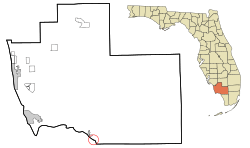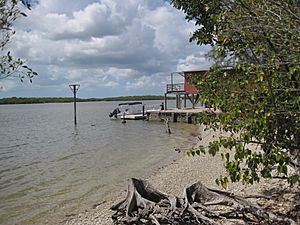Chokoloskee, Florida facts for kids
Quick facts for kids
Chokoloskee, Florida
|
|
|---|---|
 |
|

Location in Collier County and the state of Florida
|
|
| Country | |
| State | |
| County | |
| Area | |
| • Total | 0.22 sq mi (0.58 km2) |
| • Land | 0.22 sq mi (0.58 km2) |
| • Water | 0.00 sq mi (0.00 km2) |
| Elevation | 10 ft (3 m) |
| Population
(2020)
|
|
| • Total | 346 |
| • Density | 1,551.57/sq mi (599.36/km2) |
| Time zone | UTC−5 (Eastern (EST)) |
| • Summer (DST) | UTC−4 (EDT) |
| ZIP code |
34138
|
| Area code | 239 |
| FIPS code | 12-12150 |
| GNIS feature ID | 0293963 |
Chokoloskee is a small community in Collier County, Florida, United States. It's located right on the edge of the Ten Thousand Islands. In 2020, about 346 people lived there. It's part of the larger Naples area.
People have lived on Chokoloskee Island for over 1,500 years, long before Europeans arrived. Today, this quiet community relies on boating and fishing. Many visitors also come for ecotourism to the nearby Everglades National Park.
Contents
Exploring Chokoloskee's Location
Chokoloskee is a small piece of land, covering only about 0.22 square miles (0.58 square kilometers). It's all land, with no water within its official borders.
Island Setting in Florida
Chokoloskee is on Chokoloskee Island. This island sits across from the mouth of the Turner River. It's at the southeastern end of Chokoloskee Bay. The bay is about 10 miles long and 2 miles wide. It runs along the coast of Collier County.
Separated from the Gulf
The Ten Thousand Islands separate Chokoloskee Bay from the Gulf of Mexico. Chokoloskee Island is connected to Everglades City by a causeway. This causeway links the island to the mainland.
Unique Island Height
Most of the land around Chokoloskee Bay is very flat and low. But Chokoloskee Island is different. It rises to about 20 feet (6 meters) above sea level. This unusual height comes from ancient shell mounds. These mounds were built by Native Americans over 2,000 years.
Chokoloskee's Climate
Chokoloskee has a tropical climate. This means it has warm, dry winters. Its summers are hot and humid. The wet season usually lasts from April to October.
Chokoloskee's Population
The number of people living in Chokoloskee has changed over the years.
- 2000: 404 people
- 2010: 359 people
- 2020: 346 people
Who Lives in Chokoloskee?
As of the 2020 United States census, there were 346 people living in Chokoloskee. These people made up 155 households. About 106 families lived in the area. Most residents identify as White (93.64%). A smaller percentage (5.49%) are of Hispanic or Latino background.
Chokoloskee's Past: A Look Back
Chokoloskee Island has a long and interesting history.
Early Inhabitants of the Island
Native Americans lived on Chokoloskee Island for over 1,500 years. This was long before European explorers arrived. By 1763, when Spain gave Florida to Great Britain, the area was empty. In the 1800s, Seminoles and hunters sometimes visited the island.
The United States Army briefly used Chokoloskee during the Seminole Wars. In 1856, soldiers came to the island. They explored the Turner River, where they found and burned a Seminole settlement.
First Modern Settlers Arrive
The modern settlement of Chokoloskee Island began in 1874. The Santini family was one of the first to settle there. By 1880, they owned much of the island. Early residents farmed, fished, and caught turtles. They sold their extra goods in Key West.
In 1891, a post office was set up in Chokoloskee. It was first called "Comfort." Mail came by boat from Key West. Later, it came from other Florida cities as railroads grew. When the causeway to Chokoloskee Island was finished in 1956, mail came by road. People would blow a conch shell to let everyone know the mail had arrived.
Chokoloskee Island was very isolated. It was far from county seats like Key West and Fort Myers. In 1923, Collier County was created. The new county seat was Everglades City, just a few miles away. But travel was still mostly by boat until the Tamiami Trail highway was built in the late 1920s.
Ted Smallwood's Store and Legacy
In 1897, Ted Smallwood moved to Chokoloskee Island. He bought land from the Santini family and became a major landowner. He hunted alligators, cut wood, fished, and grew tomatoes.
In 1906, Ted Smallwood became the postmaster for Chokoloskee. He opened a general store that also housed the post office. He worked as postmaster until he retired in 1941. His daughter took over the job.
Ted Smallwood passed away in 1951. But his daughters kept the store running until 1982. Today, the Ted Smallwood Store is a historic landmark. It was added to the National Register of Historic Places in 1974. Ted Smallwood's granddaughter has turned the store into a museum.
The Legend of Edgar Watson
The Ten Thousand Islands area, including Chokoloskee, was known as a place where people might go to avoid trouble. One well-known story is about Edgar Watson. He arrived in the Chokoloskee Bay area in the early 1880s.
Watson was said to have been involved in various conflicts in different places. He eventually settled in the Ten Thousand Islands area. He bought land and started growing vegetables and making syrup from sugar cane.
In 1910, a big hurricane hit the area. After the storm, a difficult situation arose involving Watson and another person. When Watson returned to Chokoloskee, a group of people gathered. After a tense moment, Watson was fatally injured. The local authorities investigated, but no one was charged.
The story of Edgar Watson has become a famous legend. Author Peter Matthiessen wrote a series of books about him. The band the Decemberists also told parts of the story in their song "E. Watson."
Community Life: School, Church, and Health
Chokoloskee was a small, isolated community. It didn't always have a regular school or church. A small school building was built, and teachers sometimes came. However, many teachers didn't stay long. Children often didn't go past eighth grade until the late 1930s. Then, some started attending high school in Everglades City and Naples.
Religious services were also not regular. Priests would visit from Key West for Catholics. Protestant preachers also came to the island. A small mission church was built.
Chokoloskee Island never had a full-time physician. A man named C. G. McKinney provided most of the medical care for 50 years. He helped with injuries and illnesses. He also pulled teeth, and sometimes a traveling dentist would visit.
See also
 In Spanish: Chokoloskee para niños
In Spanish: Chokoloskee para niños


